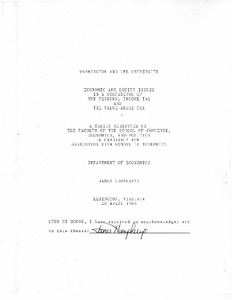| dc.rights.license | In Copyright | en_US |
| dc.creator | Humphreys, James | |
| dc.date.accessioned | 2023-10-20T18:01:00Z | |
| dc.date.available | 2023-10-20T18:01:00Z | |
| dc.date.created | 1984 | |
| dc.identifier | WLURG038_Humphreys_thesis_1984 | |
| dc.identifier.uri | https://dspace.wlu.edu/handle/11021/36474 | |
| dc.description.abstract | The four previous chapters have tried to systematically compare the United States' personal income tax and a European-style consumption value-added tax. The superiority of one tax over the other, in some cases is clear-cut, and in others is contingent on assumptions, degrees, values, or presently unknown facts. Administratively, personal income tax and the 'value-added tax have positive and negative effects. Both taxes, while complex, are not so complex that they are not functional; the costs of administering the tax are reasonable when the
amount of revenue the taxes raise is considered. The personal income tax is superior to the value-added tax administratively with respect to creating smaller excess burdens and not involving border adjustments to international transactions. The value-added tax is superior to the personal income tax in checking evasion and shrinking the size of the underground economy. Thus, the taxes' superiority depends on the size of the excess burden created by the value-added tax over that of the personal income tax, and the cost of administering border
adjustments; if their sum is greater than the portion or revenue generated from "uncovered" economic activities, the personal income tax is better than the va1ue-added tax; if their sum is less, the value-added tax is better. Allocationally, the personal income tax is more efficient than the value-added tax with respect to neutrality, and encouraging work effort at low incomes in the static marginal-utility-of-income model. The value-added tax is more efficient in allocating resources among the varying forms of business organization; in encouraging saving; in encouraging work effort in the dynamic marginal-utility-of-income model; and in allocating resources among the most productive investments. [From Conclusions] | en_US |
| dc.format.extent | 109 pages | en_US |
| dc.language.iso | en_US | en_US |
| dc.rights | This material is made available for use in research, teaching, and private study, pursuant to U.S. Copyright law. The user assumes full responsibility for any use of the materials, including but not limited to, infringement of copyright and publication rights of reproduced materials. Any materials used should be fully credited with the source. | en_US |
| dc.rights.uri | http://rightsstatements.org/vocab/InC/1.0/ | en_US |
| dc.subject.other | Washington and Lee University -- Honors in Economics | en_US |
| dc.title | Economic and Equity Issues in a Comparison of the Personal Income Tax and the Value-Added Tax | en_US |
| dc.type | Text | en_US |
| dcterms.isPartOf | WLURG038 - Student Papers | en_US |
| dc.rights.holder | Humphreys, James | en_US |
| dc.subject.fast | Income tax -- Economic aspects | en_US |
| dc.subject.fast | Value-added tax -- Economic aspects | en_US |
| local.department | Economics | en_US |
